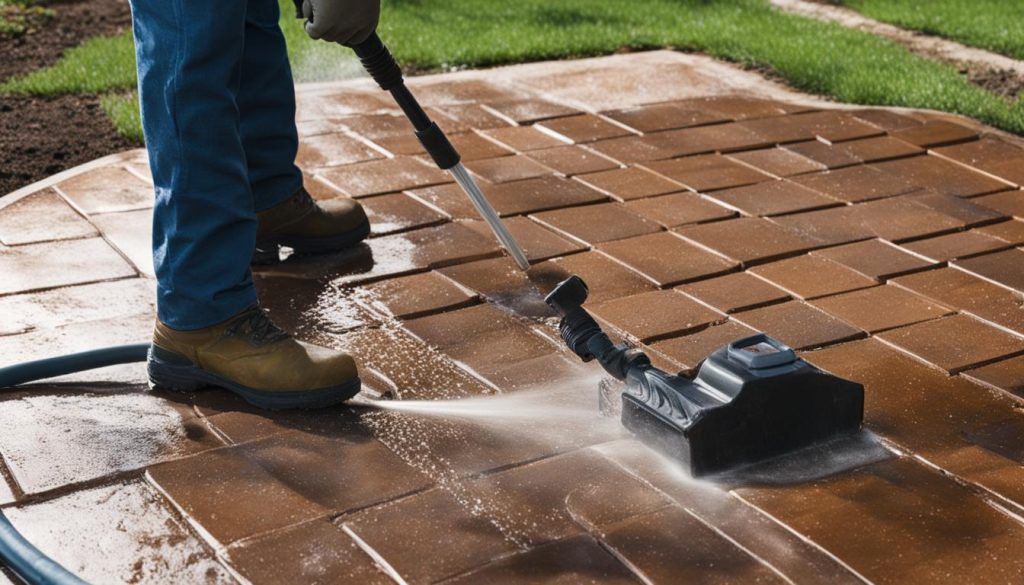Welcome to our guide on interlocking walkway maintenance! In this section, we’ll share some valuable tips and tricks for keeping your interlocking walkway in top-notch condition. By following our guidelines, you can ensure the longevity and appeal of your pathway, making it a sturdy and beautiful addition to your Canadian home.
Whether you’ve just installed a new interlocking walkway or have an existing one that needs a little TLC, regular maintenance is key. Neglecting your interlocking walkway can lead to the growth of weeds, the buildup of dirt, moss, or mold, and even damage to the pavers. That’s why maintaining your pathway is essential if you want it to look its best for years to come.
With our expert tips and tricks, you’ll be able to keep your interlocking walkway looking clean, beautiful, and safe throughout the year. From regular cleaning and sweeping to weed control, repairing damaged pavers, and snow and ice removal, we’ll cover everything you need to know about interlocking walkway maintenance.
So, let’s get started and learn how to maintain your interlocking walkway like a pro!
Regular Cleaning and Sweeping
In order to keep your interlocking walkway looking its best, regular cleaning and sweeping are crucial. By following these simple tips, you can prevent the buildup of dirt, debris, and moss, and ensure that your walkway remains a beautiful addition to your Canadian home.
Tools Needed:
- Broom or leaf blower
- Garden hose
- Mild soap
- Scrub brush
Steps:
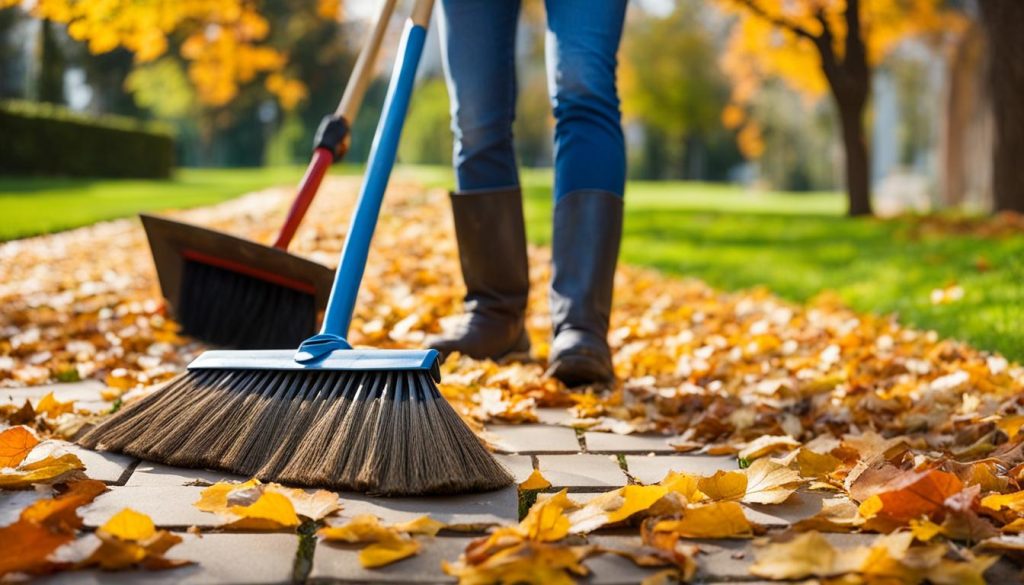
- Begin by sweeping your interlocking walkway regularly with a broom or a leaf blower to remove loose dirt and leaves from the surface.
- For tougher stains or moss, mix a mild soap with water and use a scrub brush to gently scrub the affected area. Rinse with clean water and allow the pathway to dry thoroughly before using it.
- If you notice any stubborn stains or marks, you can use a pressure washer. However, be careful not to damage the pavers.
- Regularly inspect the pathway for any signs of damage or wear and address them promptly.
- Consider sealing the interlocking pavers to protect them from stains, fading, and weather conditions. (See section 3 for more information on sealing).
By following these simple steps, you can keep your interlocking walkway clean and well-maintained for years to come. Next, we’ll cover the importance of sealing your interlocking pavers.
Sealing the Interlocking Pavers
One of the essential steps in maintaining the longevity and appeal of your interlocking walkway is sealing the interlocking pavers. This is a crucial step in protecting your pavers from stains, fading, and weather conditions, ensuring their durability. In this section, we will discuss how to properly seal your interlocking pavers.
Materials Needed:
- Pressure washer
- Broom
- Sealant
- Paint roller with extension handle
The first step in sealing the interlocking pavers is to prepare the surface by cleaning it thoroughly. Use a pressure washer to remove any dirt, debris, and weeds that may have accumulated. Allow the surface to dry completely before applying the sealant.
When selecting a sealant, choose a high-quality product that is specifically designed for interlocking pavers. Read the manufacturer’s instructions carefully before application.
Apply the sealant using a paint roller with an extension handle. Start from one end of the pathway and work your way towards the other, making sure to cover the entire surface evenly. Use a brush to apply the sealant to hard-to-reach areas and edges.
Allow the sealant to dry for at least 24 hours. In the meantime, keep foot traffic and any vehicles off the pathway.
Once the sealant is dry, inspect the surface for any missed spots or uneven coverage. Apply another coat, if necessary, and allow it to dry completely before using the pathway.
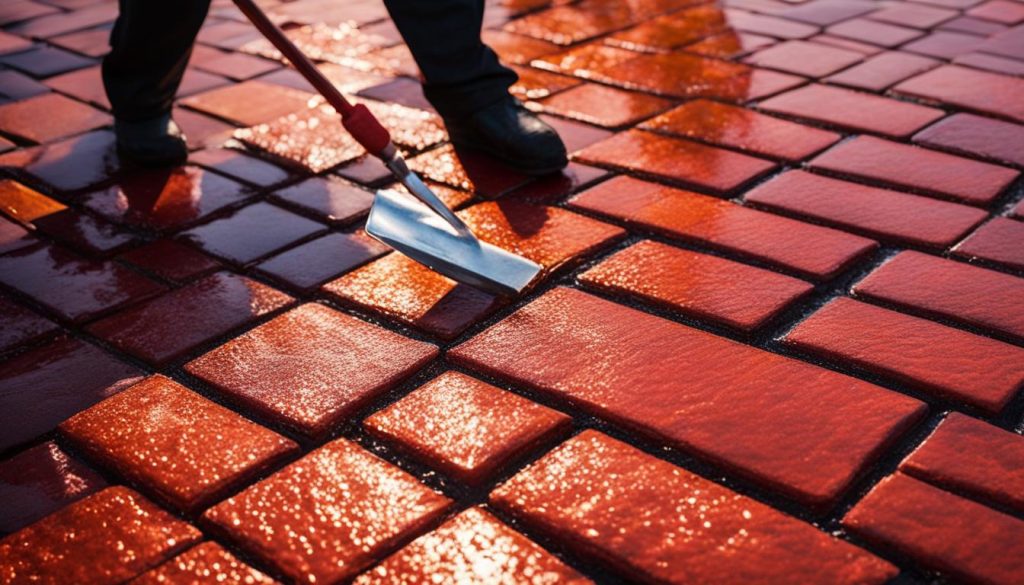
Regularly reapply the sealant every few years to ensure optimal protection of your interlocking pavers. By following these simple steps, you can maintain the aesthetic appeal and durability of your interlocking walkway for years to come.
Weed Control Tips for Your Interlocking Walkway
As we discussed in the previous section, weed control is a crucial aspect of interlocking walkway maintenance. Weeds not only detract from the appearance of your pathway but can also cause damage to the pavers over time. Here are some tips to keep your interlocking walkway free of weeds:
Regular Inspections
Regularly inspect your interlocking walkway for any signs of weed growth. Address them promptly by pulling them out of the ground or using a weed killer. It is vital to act quickly as weeds can spread rapidly, making them harder to control over time.
Weed Killer Products
When using weed killer products, be sure to use those specifically designed for interlocking surfaces. Avoid using generic weed killers as they can cause discoloration and damage to the pavers. Use the product sparingly, following the manufacturer’s instructions carefully. Apply only to the affected areas and avoid overspraying on surrounding landscape to prevent damage.
| Types of Weed Killer Products | Advantages | Disadvantages |
|---|---|---|
| Organic Weed Killers | Safe for the environment and surrounding plants, break down naturally | May take longer to see results, may require multiple applications |
| Chemical Weed Killers | Fast-acting, effective on tough weeds | Can be harmful to the environment, may cause damage to surrounding plants |
As with any chemical product, be sure to wear gloves and protective clothing when handling weed killers. Keep children and pets away from the area until the product has dried completely.
Preventive Measures
Prevention is always better than cure. You can take some measures to prevent weed growth from the outset. Regularly sweep your interlocking walkway to remove debris and dirt that may settle in between pavers. This can help create unfavorable conditions for weed growth. Additionally, consider using landscaping fabric under the pavers to prevent weed growth altogether.
By following these tips for weed control, you can ensure your interlocking walkway remains in top condition for years to come.
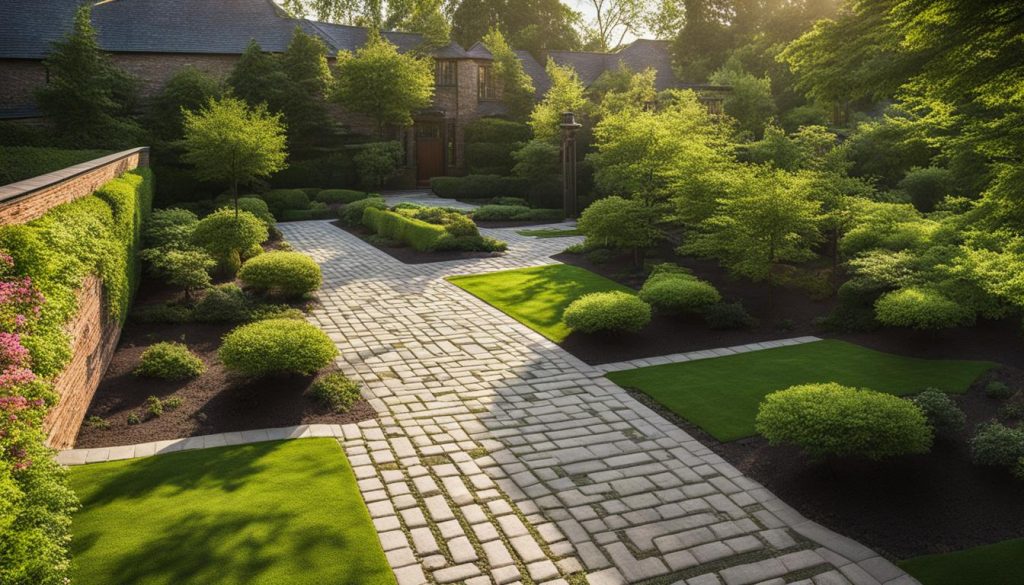
Repairing Damaged Pavers
Over time, wear and tear can cause interlocking pavers to become damaged. Cracks, chips, and displacement can compromise the integrity and safety of your interlocking walkway. Repairing these issues promptly can prevent further damage and ensure the longevity of your pathway. In this section, we will provide you with valuable tips and tricks on how to repair damaged pavers.
Replacing Damaged Pavers
If a paver is cracked or chipped, it is best to replace it with a new one. This will ensure that the pattern and color of your pathway remain consistent. Follow these steps to replace a damaged paver:
- Remove the damaged paver using a chisel and hammer. Be cautious not to damage the surrounding pavers.
- Measure the size of the opening left by the removed paver. Use these measurements to cut a new paver to fit.
- Insert the new paver into the opening, gently tapping it into place with a rubber mallet.
- Make sure the new paver is level with the surrounding pavers and use sand to fill the gaps.
Following these steps will ensure that your interlocking walkway is restored to its original condition.
Repairing Minor Damage
If the damage to a paver is minor, you may be able to repair it without replacing it. Follow these steps to repair minor damage:
- Clean the damaged area with a mixture of mild soap and water.
- Fill in any cracks or chips with a specialized repair product, following the manufacturer’s instructions.
- Smooth out the surface of the repair product and allow it to dry completely.
- Seal the repaired area with a sealant to ensure its durability and appearance.
These simple steps can save you both time and money while ensuring the safety and beauty of your interlocking walkway.
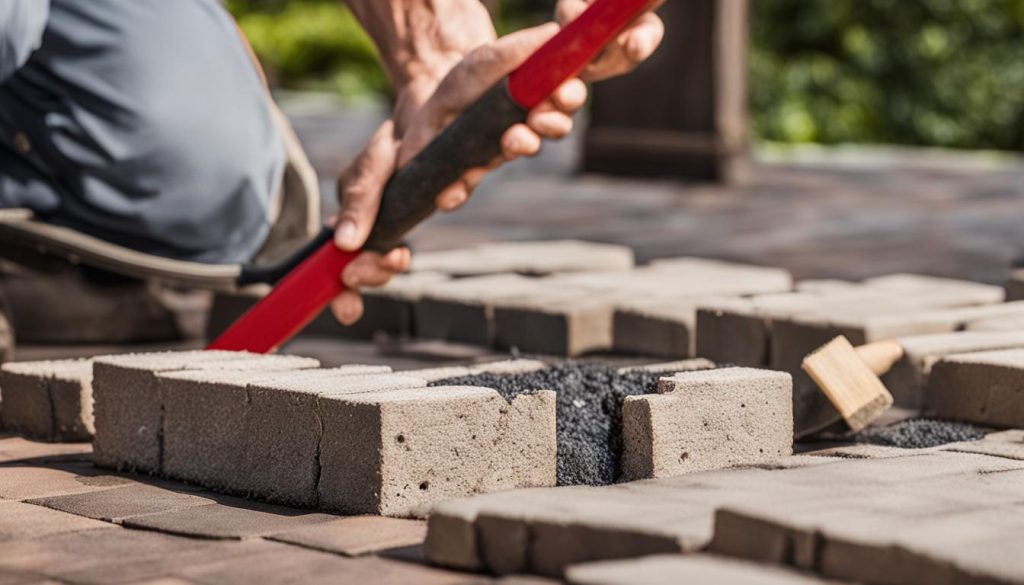
By following these tips and tricks, you can ensure that your interlocking walkway remains in top condition for years to come. Regular maintenance, including cleaning, sealing, and weed control, can also prevent damage and extend the life of your pathway. Remember, a well-maintained interlocking walkway is not only a beautiful addition to your Canadian home, but it also adds value and curb appeal.
Snow and Ice Removal
Living in Canada means we are no strangers to snow and ice, and it’s essential to know how to properly remove them from your interlocking walkway to prevent damage and accidents. Here are some tips for safe and effective snow and ice removal:
| Tools | Description |
|---|---|
| Snow shovel with a plastic blade | Use a shovel with a plastic blade to remove snow without damaging the pavers. A metal shovel can scratch and chip the surface. |
| Rubber-edged shovel | If you don’t have a plastic-bladed shovel, use a rubber-edged one, as it is less likely to damage the pavers. |
| Ice melting product | Apply a suitable ice melting product sparingly to prevent slippery conditions. Make sure to follow the manufacturer’s instructions to avoid using too much. |
When removing snow and ice, it’s important to avoid using metal shovels or ice picks, as they can damage the surface of the pavers. Additionally, don’t use salt or any other harsh chemicals for melting ice, as they can stain and degrade the pavers over time. Instead, use a product that is specifically designed for interlocking walkways.
Proper maintenance during the winter months is crucial to protect your interlocking walkway from potential damage caused by snow and ice. By following these simple tips, you can ensure your walkway remains safe and attractive all winter long.
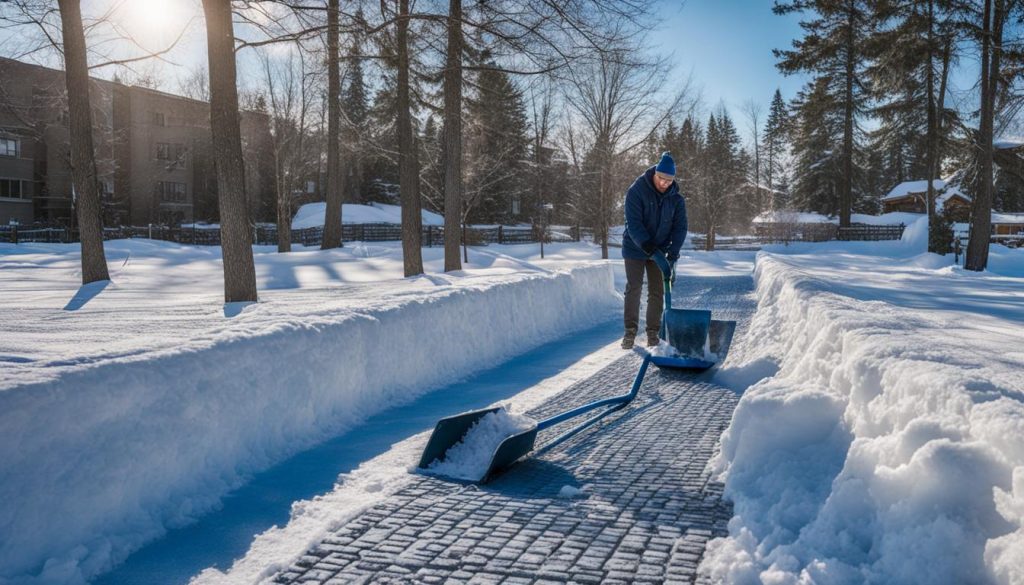
Professional Maintenance Services
If you’re looking for hassle-free interlocking walkway maintenance, consider hiring a professional service like ours. At Interlocking Contractor, we have a team of experienced professionals who specialize in interlocking walkway maintenance. We provide regular cleaning, sealing, repairs, weed control, and snow and ice removal services to keep your pathway looking its best year-round.
Our team uses only the best techniques and products to ensure optimal results. We understand that each interlocking walkway is unique, and we tailor our services to meet your specific needs. Whether you have a small walkway or a large patio, we can provide the maintenance services you need.
You can trust us to take care of your interlocking walkway as if it were our own. We take pride in our work, and we’re committed to providing exceptional service to all of our clients. Our goal is to help you maintain a beautiful and safe pathway that adds value to your Canadian home.
Why Choose Interlocking Contractor?
There are many reasons why you should choose us for your interlocking walkway maintenance needs. Here are just a few:
- We have years of experience in interlocking walkway maintenance.
- We use only high-quality products and techniques for optimal results.
- We offer competitive pricing for all of our services.
- We provide personalized service tailored to your specific needs.
- We’re committed to delivering exceptional service and customer satisfaction.
So if you’re looking for professional interlocking walkway maintenance services, look no further than Interlocking Contractor. Contact us today at (647) 812-9803 or visit our website at https://www.interlockingcontractor.ca/ to learn more about our services and to request a quote. We look forward to working with you!
FAQ
How often should I clean and sweep my interlocking walkway?
It is recommended to clean and sweep your interlocking walkway regularly to prevent the buildup of dirt, debris, and moss. Aim to do this at least once a month or as needed, depending on the level of foot traffic and environmental conditions.
How do I clean tough stains or moss from my interlocking walkway?
For tougher stains or moss, gently scrub the affected area with a mixture of mild soap and water. Rinse with clean water and allow the pathway to dry thoroughly before using it. Avoid using harsh chemicals or abrasive cleaners as they may damage the pavers.
Should I seal my interlocking pavers?
Yes, sealing the interlocking pavers is important for their longevity and appearance. Apply a sealant to the clean and dry surface of the pavers, following the manufacturer’s instructions. Regularly reapply the sealant every few years to ensure optimal protection against stains, fading, and weather conditions.
How can I control weeds on my interlocking walkway?
Keeping weeds at bay is crucial for maintaining the integrity of your interlocking walkway. Promptly remove any weeds or grass that grow in between the pavers. You can use a weed killer specifically designed for use on interlocking surfaces, but be cautious not to damage the surrounding landscape.
What should I do if my interlocking pavers get damaged?
If your interlocking pavers become chipped, cracked, or displaced, it is important to repair them promptly. Replace any damaged pavers with new ones, ensuring they match the existing pattern and color. For minor damage, you may be able to reposition the pavers or fill in cracks with specialized repair products.
How should I remove snow and ice from my interlocking walkway?
During Canadian winters, use a snow shovel with a plastic blade or a rubber-edged shovel to remove snow without damaging the pavers. Avoid using metal shovels or ice picks as they can scratch or chip the surface. Apply a suitable ice melting product sparingly, following the manufacturer’s instructions, to prevent slippery conditions.
Can I hire professionals to maintain my interlocking walkway?
Yes, if you prefer to leave the maintenance of your interlocking walkway to the professionals, consider hiring a reputable interlocking contractor like Interlocking Contractor. They offer regular maintenance services, including cleaning, sealing, repairs, and weed control, to ensure your interlocking walkway remains in top condition throughout the year. Contact them today at (647) 812-9803 or visit their website at https://www.interlockingcontractor.ca/ for more information.

